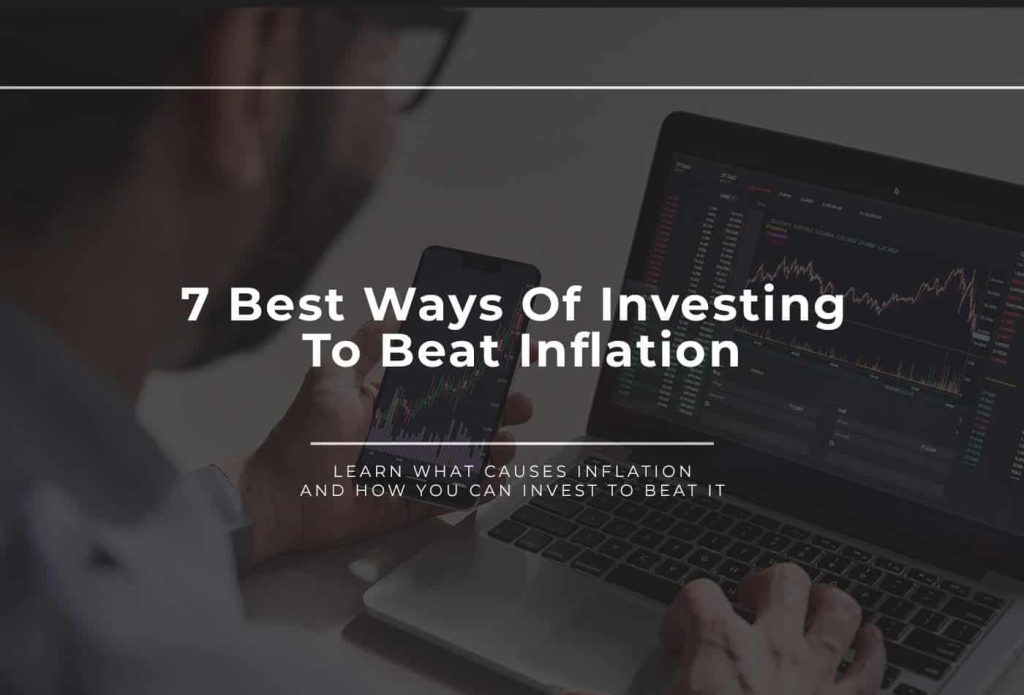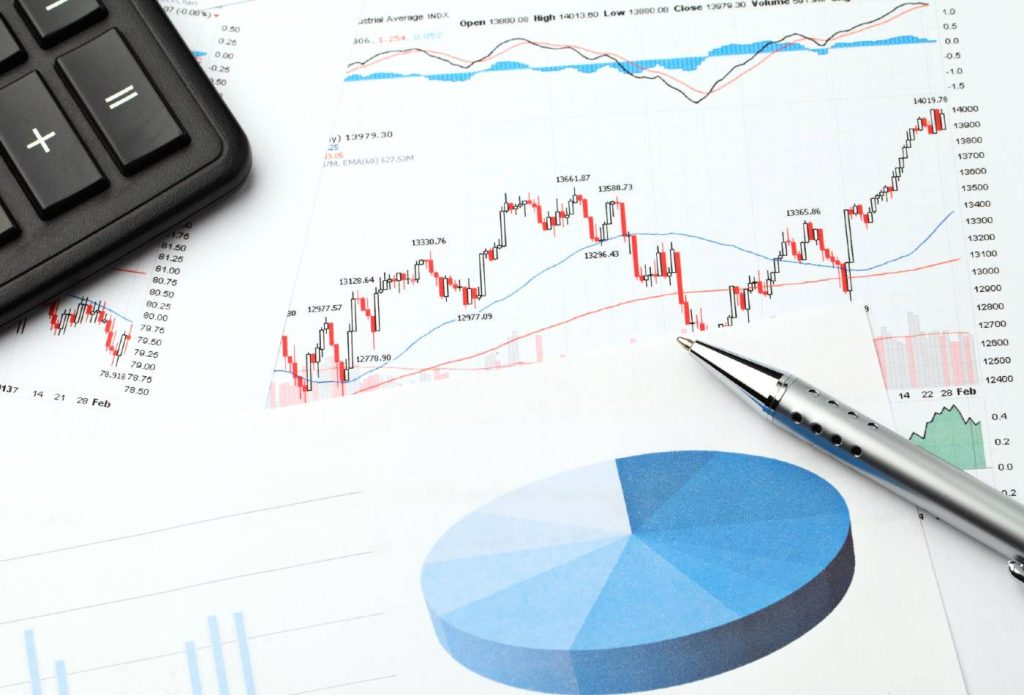This article was last updated on June 10, 2022
Inflation is the enemy of the long-term investor. Regardless of whether you are holding assets for retirement or simply building equity, sudden jumps in inflation can quickly reduce the value of your holdings and lower your returns. However, some assets are far more resistant to fluctuations in currency value than others. As a result, investors and economists have figured out ways of investing to beat inflation.
In today’s guide, we will be taking a look at what inflation is, what causes it, and what you can do to avoid its negative impact on your assets in the long term.
Table of contents
What Is Inflation?
Simply put, inflation is the devaluation of a given currency. This occurs when its purchasing power decreases and you need more of it to buy the same equity. This is best exemplified by a rise in the prices of everyday goods and services. As these prices increase, buyers need more of the currency to purchase what they used to. This, in turn, means that more money is required in circulation, and the government has to issue it.
The larger the money supply in circulation is, the lower its value becomes. To offset this, a country’s central banking institution will continuously monitor the amount of issued currency and credit. If these are too high, the regulator will take the proper measures to curtail them. In such instances, the central bank can enact monetary policies that promote consumer spending or take a more frugal approach.
What Causes Inflation?
A country’s economy is a very complex mechanism. As such, there are numerous factors that can affect it and cause currencies to drop in value. However, over the years, economists have identified three distinct ways that inflation can occur.
By clearly outlining these, governments and financial institutions can monitor events that can lead to inflation and attempt to resolve them preemptively. Knowing how to spot approaching decreases in currency value also helps you with investing to beat inflation.
Cost-Push
Cost-push inflation is caused by a rise in the prices of the production process and resources. When these are more expensive, the price hike carries over to the resulting products and eventually reaches the end consumer.
This often occurs when supply chains are broken or sudden shortages of key commodities take place. In such cases, it becomes increasingly difficult for manufacturers and producers to provide goods and services. To make their businesses feasible, they will increase prices.
Demand-Pull
Demand-pull is another example where manufacturers will raise prices. However, in this case, they do so because the demand for particular goods or services is too high. This occurs due to an increase in the money in circulation.
During such periods, consumers have excess funds, increasing their spending power. However, as the supply of goods remains the same, producers cannot meet the newly increased demand. To combat this, they will raise prices.
Built-In
Built-in inflation occurs naturally over time. In general, people expect a certain percentage of inflation to develop over the course of the year. As a result, they will require an annual increase in wages to compensate for this and maintain their standard of living.
However, as wages increase, the value of the currency decreases. This further increases inflation and causes additional raises in prices. As a result, a wage-cost spiral is created where both cost-push and demand-pull inflations occur.
Measuring Inflation Before Investing To Beat It
In order to invest to beat inflation, you will first need to measure inflation. While there are numerous online calculators and tools available that can do this, it is always a good idea to understand the mechanics behind the process. In general, inflation is measured by evaluating two main price indices.
Consumr Price Index (CPI)
The first is the Consumer Price Index. This is an average of the prices for everyday goods and services that people use. Examples can be staple foods, medical services, and more.
As you might have guessed by the name, economists use the CPI to gauge the cost of everyday living in a country or region. They do so by evaluating the price changes of the individual goods from the abovementioned group. They will then compare these to the overall price changes in the group as a whole.
Wholesale Price Index (WPI)
The WPI is somewhat similar to the CPI in that it measures the prices of staple goods. However, in this case, they are wholesale goods that producers use to manufacture products. These are usually the means of production and can include cotton, wheat, metals, oil, and more.
Usually, WPI is more closely associated with cost-push inflation, as it is concerned with producer-level costs. As this index increases, so will the costs of production. This will then translate into an increase in end prices.
Investing To Beat Inflation
So, how can people set up a strategy to invest to beat inflation? There are various ways to achieve this. In general, investing in various inflation-resistant assets and keeping your money in equity over the long term are good ideas. This will greatly reduce the effect that fluctuations of currency value have on your capital.
Here are some good examples of inflation-resistant assets:
Real Estate
Real Estate property is one of the oldest and possibly safest ways to invest your money. When looking at historical real estate prices, they have only gone up. This has only been upset by the occasional slight dip due to instability in the world economy. As a result, real estate is ideal when investing to beat inflation. However, as there are different ways that you can invest in real estate, only some of them will help you ward off the devaluation of your money.
Purchasing a property to hold for the long term is a good way to store your capital. It makes it much less affected by fluctuations in currency value and also gives you a stable income of funds. Since the property is yours, you can choose to rent it out to tenants in exchange for regular payments. Additionally, as time passes, its overall price will usually increase, meaning that you can later sell it at a profit.
However, real estate investing approaches also include “flipping” property. These are practices where people will purchase and sell real estate within a short period of time. While this can be very profitable, it does not help combat inflation, as it does not alter your equity state.
Investing In Stocks To Beat Inflation
Stocks are another great way of investing to beat inflation. Much like real estate, they are a form of equity that has a monetary value. As money loses its value, the price of your stocks will increase, along with all other goods and services. As a result, if you choose to sell them later down the line, the new price will somewhat compensate for the accumulated inflation. While this will not recoup all of your losses accrued due to inflation, it will offset them significantly.
Additionally, should the market or underlying company do well, holders also receive dividends in the form of price increases. This can be a great way to create additional revenue streams as long as the returns are more significant than the inflation rate.
Treasury Inflation-Protected Securities (TIPS)
As the name suggests, TIPS are securities that are made to withstand the negative impacts of inflation. In fact, their principal value actually rises with inflation which means that so do the interest rates. These securities are issued by the U.S. government and will usually come with maturities of five, ten, or 30 years.
As a result, TIPS are a popular way to diversify portfolios and ensure them against inflation. By adding such securities to your holdings, you will be able to offset losses accrued due to the devaluation of currencies.
However, treasury inflation-protected securities do come with downsides. A significant one is that the government does consider the biannual price adjustments on TIPS to be taxable income. This means that you will have to add them to your tax returns, even though you won’t actually see any income until you decide to sell the asset.
Another con here is that the interest rates on TIPS are lower than most other bonds and securities available on the market. As such, they are more of a tool for inflation protection rather than investments. If you are looking for revenue streams, then this might not be ideal for your situation.
Investing In Annuities To Beat Inflation
If you are trying to save money for the long run so that you have an income in retirement, then Annuities are a great way of investing to beat inflation. Basically, these are insurance retirement plans that help you set aside money for the future.
With annuities, investors will pay a monthly fee while they are working and have an active source of income. Alternatively, they can purchase a plan with a one-time payment should they have sufficient capital. Later down the line, all invested funds, along with interest, will be paid out to you. These payments will come on a regular basis, providing you with a steady income.
While not all annuities offer inflation protection, some of the available plans are a good way to safeguard your capital. Fixed annuities, for one, will apply a fixed interest rate on your investment. This means that regardless of how well your assets do on the market, the payments will still be based on that same interest.
As retirement-focused, Annuities are also tax-deferred. This means that you won’t have to pay taxes while you are accumulating interest rates. Instead, the entire accrued amount is taxed at once when you decide that you would like to start receiving payments from the plan.
Investing In Unique Goods And Collectibles To Beat Inflation
When trying to beat inflation, investing in one-of-a-kind items can be a great strategy. Collectibles and valuables limited to only a few in existence can fetch a significant price on the market. Assets such as art, luxury goods, collectible items, and others are a good way to store money in times of volatility. This strategy has become so prominent in recent years, that a whole market for trading in whisky and other high-end liquors has appeared.
Such goods will only increase in value in most cases and are always sought after. While prices in the art and collector fields can be ludicrous, they get even crazier in times of inflation and uncertainty. Investors will often buy them up to secure their holdings and diversify portfolios.
Exchange Traded Funds (ETF)
ETFs are securities that represent the performance and price of commodities, assets, industry sectors, indices, and other instruments. These can be bought or sold just like any other asset on the market and are a great way of investing to beat inflation.
While not inflation-resistant themselves, ETFs can represent many commodities and assets that are. Funds like the SPDR S&P 500 (SYP) are well-known staples on the market that provide secure and low-volatility investment opportunities. Since ETFs work in a similar way to stocks, they also offer many of the same advantages.
Not only are they highly liquid, but they also offer favorable taxation schemes. Just like stocks and other assets, ETFs are not subject to taxation until they are sold. Additionally, they also provide holders with dividends, allowing you to offset losses accrued due to inflation.
Collateralized Loan Obligation (CLO)
CLOs are securities that represent multiple loans pooled into one asset. These loans are usually taken out by companies and corporations with low credit ratings. As such, CLOs can be a risky investment, as the chance of the loanee defaulting on their loan is higher than usual. However, if successful, CLOs will provide you with regular monthly payments from the repayment of the loan.
Closing Thoughts On Investing To Beat Inflation
All of the above-mentioned strategies are good ways of investing to beat inflation. If you want to protect your long-term investments ensure your capital for the future, then these are all good places to start. Taking any one or several of these approaches will help you diversify your portfolio with inflation-resistant assets and secure your financial well-being when going into retirement or simply looking into the future.
Although some of the ventures above come with a bit of a risk, few things in life do not. If you want to acquire new income streams and have a secure future, you will need to take risks in the present.





